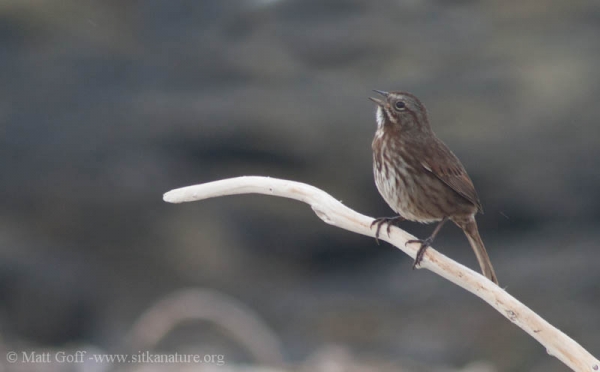My second post in the series about singing birds around Sitka is on the sparrows. (previously I wrote about Thrushes). There are only four commonly breeding sparrows known from the Sitka area. There are some additional species that migrate through and may be heard singing during a brief window of time in spring, but I’ll save those for another time.
As a whole, the sparrow songs present a bit more of a challenge than the thrushes. Dark-eyed Junco wouldn’t be mistaken for any other sparrow around Sitka, but it can be a challenge to learn to distinguish from Orange-crowned Warbler. Although their songs are fairly distinct, they are not necessarily so easy to describe and/or imitate, which contributes to the challenge of getting a feel for the differences between Song Sparrows, Fox Sparrows, Lincoln’s Sparrows and some of the warblers.
- Dark-eyed Junco
- Song consists of a simple trill that generally stays at the same pitch
- Speed of trill is generally consistent, but occasionally they will mix in a much faster trill
- Most likely to be confused with Orange-crowned Warbler whose song usually changes pitch
- Juncos are found from sea level to tree line. They seem fond of forest edges, and utilize residential areas with mixed treed and open habitats
- Juncos are present year round and often start singing while still in their large winter flocks.
- All about birds page for Dark-eyed Junco
- Song Sparrow
- Song often starts with a pitched repeated two or three times before going into the rest of the song
- In studies done elsewhere, individual males typically have 5-8 songs they will sing (with all the residential singers in Sitka it would be interesting to see if that’s true here as well)
- Listen for buzzy trills in songs to help distinguish it from the somewhat similar (looking and sounding) Fox Sparrow
- Common in residential areas where there is sufficient brushy habitat . Also found along beach margins (as well as harbors, both the floats and the breakwaters); they do not seem to occur elsewhere
- Present year round (though wintering birds are not necessarily same as breeding birds). They start singing by March.
- All about birds page for Song Sparrow
- Fox Sparrow
- Song has beeps and whistles reminiscent of R2-D2 (from Star Wars), which may be the easiest way to tell it apart from the Song Sparrow
- Utilizes brush areas from sea level to tree line. Seem to be less common than Song Sparrows in most residential neighborhoods around Sitka.
- Winter in small numbers, can be abundant during migration – singing probably starts in April (I should check my records).
- All about birds page for Fox Sparrow
- Lincoln’s Sparrow
- Song is something like a bubbling trills
- Found at the edge of wet areas including Swan Lake, Starrigavan Estuary, and muskegs.
- Once recognized, song probably not easily mistaken for anything else that occurs in Sitka, though it might give the impression of something warbler-like.
- Does not typically winter in Sitka, our latest arriving sparrow. I should check records, but it seems like late April is when they might start singing.
- All about birds page for Lincoln’s Sparrow

